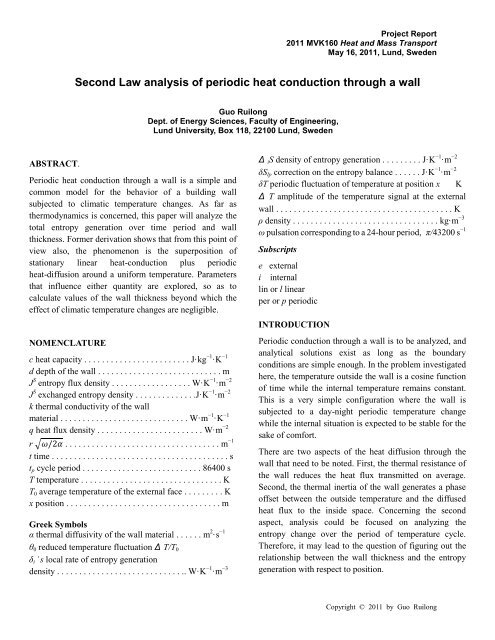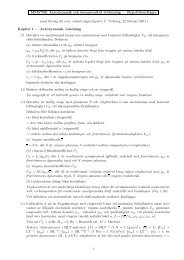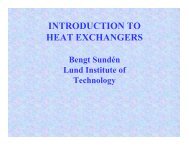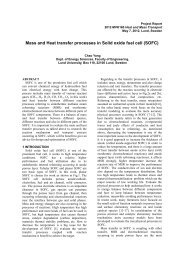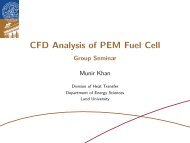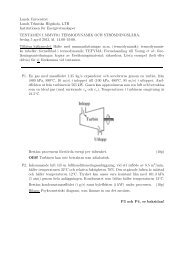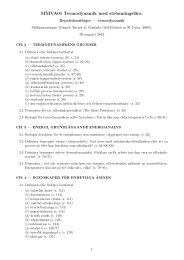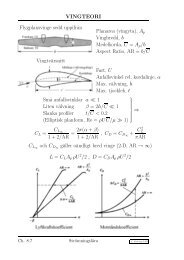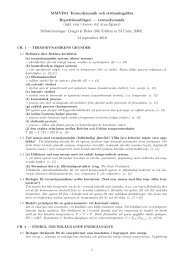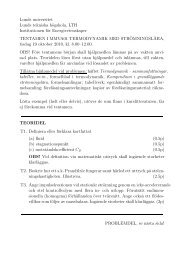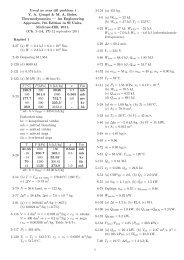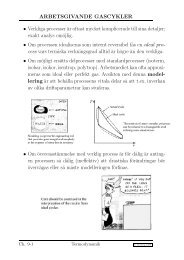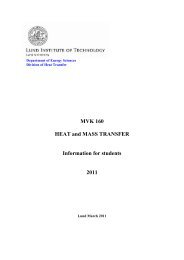Second Law analysis of periodic heat conduction through a wall
Second Law analysis of periodic heat conduction through a wall
Second Law analysis of periodic heat conduction through a wall
You also want an ePaper? Increase the reach of your titles
YUMPU automatically turns print PDFs into web optimized ePapers that Google loves.
Project Report<br />
2011 MVK160 Heat and Mass Transport<br />
May 16, 2011, Lund, Sweden<br />
<strong>Second</strong> <strong>Law</strong> <strong>analysis</strong> <strong>of</strong> <strong>periodic</strong> <strong>heat</strong> <strong>conduction</strong> <strong>through</strong> a <strong>wall</strong><br />
Guo Ruilong<br />
Dept. <strong>of</strong> Energy Sciences, Faculty <strong>of</strong> Engineering,<br />
Lund University, Box 118, 22100 Lund, Sweden<br />
ABSTRACT.<br />
Periodic <strong>heat</strong> <strong>conduction</strong> <strong>through</strong> a <strong>wall</strong> is a simple and<br />
common model for the behavior <strong>of</strong> a building <strong>wall</strong><br />
subjected to climatic temperature changes. As far as<br />
thermodynamics is concerned, this paper will analyze the<br />
total entropy generation over time period and <strong>wall</strong><br />
thickness. Former derivation shows that from this point <strong>of</strong><br />
view also, the phenomenon is the superposition <strong>of</strong><br />
stationary linear <strong>heat</strong>-<strong>conduction</strong> plus <strong>periodic</strong><br />
<strong>heat</strong>-diffusion around a uniform temperature. Parameters<br />
that influence either quantity are explored, so as to<br />
calculate values <strong>of</strong> the <strong>wall</strong> thickness beyond which the<br />
effect <strong>of</strong> climatic temperature changes are negligible.<br />
NOMENCLATURE<br />
−1<br />
c <strong>heat</strong> capacity . . . . . . . . . . . . . . . . . . . . . . . . J·kg<br />
−1·K<br />
d depth <strong>of</strong> the <strong>wall</strong> . . . . . . . . . . . . . . . . . . . . . . . . . . . . m<br />
J S −2<br />
entropy flux density . . . . . . . . . . . . . . . . . . W·K<br />
−1·m<br />
J S −2<br />
exchanged entropy density . . . . . . . . . . . . . .J·K<br />
−1·m<br />
k thermal conductivity <strong>of</strong> the <strong>wall</strong><br />
−1<br />
material . . . . . . . . . . . . . . . . . . . . . . . . . . . . . W·m<br />
−1·K<br />
q <strong>heat</strong> flux density . . . . . . . . . . . . . . . . . . . . . . . . W·m −2<br />
r . . . . . . . . . . . . . . . . . . . . . . . . . . . . . . . . . . . m −1<br />
t time . . . . . . . . . . . . . . . . . . . . . . . . . . . . . . . . . . . . . . . . s<br />
t p cycle period . . . . . . . . . . . . . . . . . . . . . . . . . . . 86400 s<br />
T temperature . . . . . . . . . . . . . . . . . . . . . . . . . . . . . . . . K<br />
T 0 average temperature <strong>of</strong> the external face . . . . . . . . . K<br />
x position . . . . . . . . . . . . . . . . . . . . . . . . . . . . . . . . . . . m<br />
Δ<br />
Greek Symbols<br />
−1<br />
α thermal diffusivity <strong>of</strong> the <strong>wall</strong> material . . . . . . m<br />
2·s<br />
θ 0 reduced temperature fluctuation Δ T/T 0<br />
δ i ˙s local rate <strong>of</strong> entropy generation<br />
−3<br />
density . . . . . . . . . . . . . . . . . . . . . . . . . . . . .. W·K<br />
−1·m<br />
−2<br />
i S density <strong>of</strong> entropy generation . . . . . . . . . J·K<br />
−1·m<br />
−2<br />
δS lp correction on the entropy balance . . . . . . J·K<br />
−1·m<br />
δT <strong>periodic</strong> fluctuation <strong>of</strong> temperature at position x K<br />
Δ T amplitude <strong>of</strong> the temperature signal at the external<br />
<strong>wall</strong> . . . . . . . . . . . . . . . . . . . . . . . . . . . . . . . . . . . . . . . . K<br />
ρ density . . . . . . . . . . . . . . . . . . . . . . . . . . . . . . . . . kg·m −3<br />
ω pulsation corresponding to a 24-hour period, π/43200 s −1<br />
Subscripts<br />
e external<br />
i internal<br />
lin or l linear<br />
per or p <strong>periodic</strong><br />
INTRODUCTION<br />
Periodic <strong>conduction</strong> <strong>through</strong> a <strong>wall</strong> is to be analyzed, and<br />
analytical solutions exist as long as the boundary<br />
conditions are simple enough. In the problem investigated<br />
here, the temperature outside the <strong>wall</strong> is a cosine function<br />
<strong>of</strong> time while the internal temperature remains constant.<br />
This is a very simple configuration where the <strong>wall</strong> is<br />
subjected to a day-night <strong>periodic</strong> temperature change<br />
while the internal situation is expected to be stable for the<br />
sake <strong>of</strong> comfort.<br />
There are two aspects <strong>of</strong> the <strong>heat</strong> diffusion <strong>through</strong> the<br />
<strong>wall</strong> that need to be noted. First, the thermal resistance <strong>of</strong><br />
the <strong>wall</strong> reduces the <strong>heat</strong> flux transmitted on average.<br />
<strong>Second</strong>, the thermal inertia <strong>of</strong> the <strong>wall</strong> generates a phase<br />
<strong>of</strong>fset between the outside temperature and the diffused<br />
<strong>heat</strong> flux to the inside space. Concerning the second<br />
aspect, <strong>analysis</strong> could be focused on analyzing the<br />
entropy change over the period <strong>of</strong> temperature cycle.<br />
Therefore, it may lead to the question <strong>of</strong> figuring out the<br />
relationship between the <strong>wall</strong> thickness and the entropy<br />
generation with respect to position.<br />
Copyright © 2011 by Guo Ruilong
Ideal processes, second-law <strong>analysis</strong> are used to evaluate<br />
the problem. Heat diffusion is the only source <strong>of</strong><br />
irreversibility, and the calculation <strong>of</strong> total entropy change<br />
is the main part <strong>of</strong> this paper. The sensitivity <strong>of</strong> the results<br />
with respect to <strong>heat</strong> capacity or climatic conditions is<br />
studied.<br />
PROBLEM STATEMENT<br />
The model used to investigate this problem is that a solid<br />
<strong>wall</strong>, single-phase, homogeneous, is subjected to a<br />
fluctuating external temperature and an ideally constant<br />
internal temperature. The boundary conditions are:<br />
(1)<br />
and to the boundary conditions, it is easily shown that the<br />
solution for temperature is the sum <strong>of</strong> a linear component<br />
between T 0 and T i (denoted linear in the following) plus a<br />
purely sinusoidal component (denoted <strong>periodic</strong> in the<br />
following):<br />
, with<br />
and<br />
with<br />
and<br />
(2)<br />
(3)<br />
where r<br />
stands for . From those equations, it can easily be<br />
seen that the <strong>heat</strong> flux density q (given by the Fourier’s<br />
law:<br />
) is the sum <strong>of</strong> two components, a<br />
constant and uniform one derived from the gradient <strong>of</strong><br />
, plus a purely <strong>periodic</strong> one derived from the gradient<br />
<strong>of</strong> . The total <strong>heat</strong> flux density is thus:<br />
(4)<br />
Figure 1. Schematic representation <strong>of</strong> the studied case<br />
As is shown in Figure 1, the amplitude for external<br />
temperature change is , which is arbitrarily fixed at 15<br />
K. The inner temperature Ti is fixed at 25 ◦C. We also<br />
consider three values <strong>of</strong> T 0 : , called ―standard case‖<br />
in the following and more or less representing conditions<br />
in summer; , with equality between T 0 and , as it<br />
<strong>of</strong>ten occurs in spring or autumn; and , that we<br />
schematically denote as winter. The standard material <strong>of</strong><br />
the <strong>wall</strong> is defined by:<br />
and<br />
Only the <strong>periodic</strong> regime is considered. After the period<br />
, the <strong>wall</strong> recovers the same thermodynamical state, and<br />
the change <strong>of</strong> any state function (e.g., temperature,<br />
internal energy and entropy) is zero over a period.<br />
According to the partial derivative equation ( )<br />
At this point <strong>of</strong> the development, let us refer to the<br />
well-known problem <strong>of</strong> the 1D semi-infinite <strong>wall</strong><br />
submitted to a cosine temperature change on its boundary<br />
. With our notations, the <strong>periodic</strong>al solution for<br />
temperature is:<br />
Inside the semi-infinite <strong>wall</strong>, the amplitude <strong>of</strong> the<br />
temperature signal decreases as i.e. the amplitude<br />
is 10% <strong>of</strong> the external constraint for<br />
for our standard case), and only 5% for<br />
. It can reasonably be said that the<br />
external temperature signal is almost completely filtered<br />
beyond the position .<br />
In the present problem, the <strong>wall</strong> depth is finite and<br />
temperature is fixed at the internal boundary; moreover<br />
we are mainly interested in <strong>heat</strong> fluxes. If one compares<br />
the amplitudes <strong>of</strong> the (<strong>periodic</strong>al) <strong>heat</strong> flux density, first<br />
at the internal boundary <strong>of</strong> the finite <strong>wall</strong> with depth d,<br />
and second at the position in the semi-infinite <strong>wall</strong>,<br />
Copyright © 2011 by Guo Ruilong
then, for , the former amplitude is about twice<br />
the latter (exactly twice for thick <strong>wall</strong>s). Indeed, fixing<br />
temperature at a given position is a constraint that<br />
increases the <strong>heat</strong> flux compared to the semi-infinite <strong>wall</strong>.<br />
As a result, the internal boundary <strong>of</strong> a finite <strong>wall</strong> with d =<br />
0.5 m is as active as the position x = 0.38 m in the<br />
semi-infinite <strong>wall</strong>, so that considering <strong>wall</strong>s as thick as<br />
0.5 m is relevant in the present problem.<br />
LITERATURE SURVEY<br />
F. Strub, M. Strub, J. Castaing-Lasvignottes, J.P.<br />
Bédécarrats, [3] has done a research on this specific topic<br />
and they has also analyzed it using another method: the<br />
Carnot cycle to calculating the optimal energy<br />
consumption to keep the internal temperature constant.<br />
This approach generates a different results from the one<br />
used in this paper, which raises questions and further<br />
study.<br />
PROJECT DESCRIPTION<br />
-----Analysis based on entropy generation<br />
The local rate <strong>of</strong> entropy generation density in<br />
one-dimensional <strong>heat</strong> diffusion is well known:<br />
Once T and q are known, integration <strong>of</strong> over space<br />
and time yields the total entropy generation over the cycle.<br />
However, in the <strong>periodic</strong> regime, the <strong>analysis</strong> is easier to<br />
develop when considering the rates <strong>of</strong> entropy flux<br />
densities<br />
at the boundaries, the balance <strong>of</strong><br />
which, integrated over the cycle period tp, is the total<br />
entropy generation :<br />
At the internal boundary, , the temperature is fixed<br />
at . Developing the <strong>heat</strong> flux according to Eq. (4), and<br />
considering that the integral <strong>of</strong> the <strong>periodic</strong> part over the<br />
cycle period vanishes ( ), it appears that the total<br />
entropy flux density at the internal boundary only<br />
involves the stationary <strong>heat</strong> flux:<br />
(5)<br />
(6)<br />
At the external face (x = 0), the boundary condition (1)<br />
can be written slightly differently:<br />
The<br />
entropy flux involves Denoting ,<br />
which surely is less than 1 (in our case ), the<br />
expansion in series <strong>of</strong> is:<br />
In the following, this expansion<br />
will be limited to the first terms and the notation is<br />
used only in series expansions. As for <strong>heat</strong> flux, the linear<br />
and <strong>periodic</strong> parts <strong>of</strong> the entropy flux, and in<br />
rates, are considered. The former is obviously<br />
. Developing as described above<br />
up to , and remembering that only the even powers<br />
<strong>of</strong> have non-zero integrals over the cycle period,<br />
leads to the entropy flux over a cycle<br />
The <strong>periodic</strong> part <strong>of</strong><br />
<strong>heat</strong> flux density at<br />
involves the <strong>periodic</strong> part <strong>of</strong> the<br />
given by:<br />
The time dependence involves terms in and terms<br />
in . Combination with the expansion <strong>of</strong><br />
yields terms in or in .<br />
Here again, only the even powers <strong>of</strong> have<br />
non-zero integrals over the cycle period. Additional<br />
algebra yields the time integral <strong>of</strong> :<br />
The entropy fluxes can be rearranged differently,<br />
evidencing an interesting property <strong>of</strong> the total entropy<br />
generation. Indeed, Eq. (5) can be rewritten as:<br />
or<br />
(7)<br />
, a form which introduces the two<br />
following quantities and<br />
Simple developments with the first terms <strong>of</strong><br />
the above-described expansions lead to:<br />
Copyright © 2011 by Guo Ruilong
And<br />
This development demonstrates that the total entropy<br />
generation can be represented as the sum <strong>of</strong> three<br />
quantities. The first, , is the entropy generation <strong>of</strong><br />
stationary <strong>heat</strong> <strong>conduction</strong> along the average linear<br />
temperature gradient; is completely independent <strong>of</strong><br />
_T . The second, , is the entropy generation <strong>of</strong> purely<br />
<strong>periodic</strong> <strong>heat</strong> diffusion in the <strong>wall</strong> oscillating around the<br />
temperature T0 with Eq. (1) as constraint; is<br />
(8)<br />
(9)<br />
completely independent <strong>of</strong> Ti . The third quantity, ,<br />
is only a correction (on the order <strong>of</strong> when compared<br />
to with a sign opposite to that <strong>of</strong> ( ).<br />
in the present case), beyond which<br />
hardly<br />
changes. As a consequence the curve presents a<br />
knee at that same abscissa. According to these results, it<br />
could be deduced that the only effect <strong>of</strong> increasing the<br />
<strong>wall</strong> thickness beyond that minimum consists in reducing<br />
<strong>heat</strong> <strong>conduction</strong> thanks to a larger thermal resistance,<br />
without any effect related to the <strong>periodic</strong> <strong>heat</strong> <strong>conduction</strong>.<br />
CONCLUSIONS<br />
Periodic <strong>heat</strong> <strong>conduction</strong> <strong>through</strong> a <strong>wall</strong> is a practical<br />
problem, and the case studied above is simplified by<br />
regarding the <strong>wall</strong> as homogeneous, the internal<br />
temperature as constant and the day-night cycle as<br />
unchanged all year. The <strong>analysis</strong> <strong>of</strong> this problem leads to a<br />
better understanding <strong>of</strong> the <strong>heat</strong> <strong>conduction</strong> <strong>through</strong> the<br />
<strong>wall</strong>, which consists <strong>of</strong> two parts: stationary <strong>heat</strong> diffusion<br />
and <strong>periodic</strong> one. <strong>Second</strong> law and entropy generation are<br />
used as the approach to tackle the problem herein, and the<br />
results, to certain degree, shows an evidencing value <strong>of</strong><br />
the <strong>wall</strong> thickness, beyond which entropy generation<br />
hardly changes. However, given the assumptions, this<br />
result can be different to the ones get <strong>through</strong> other<br />
methods. Therefore, further research concerning this<br />
problem should be done with other approaches and more<br />
realistic circumstances, so as to gain better understanding<br />
<strong>of</strong> the real problem.<br />
Figure 2. Entropy generation as a function <strong>of</strong> <strong>wall</strong> depth. Linear<br />
component , <strong>periodic</strong> component , total , and sum<br />
.<br />
Fig. 2 presents the curves , and as<br />
functions <strong>of</strong> the <strong>wall</strong> depth d for the standard case.<br />
Several features are noteworthy. First, the curve<br />
is a very good approximation <strong>of</strong> : the<br />
total entropy generation is practically the sum <strong>of</strong><br />
stationary <strong>heat</strong> <strong>conduction</strong> <strong>through</strong> the <strong>wall</strong> between<br />
and , plus <strong>periodic</strong> <strong>heat</strong> diffusion in the <strong>wall</strong> averagely<br />
at T0. <strong>Second</strong>, and are very similar for thin<br />
<strong>wall</strong>s ( ), but for thick <strong>wall</strong>s ( ) the<br />
former tends to vanish while the latter tends toward an<br />
asymptotic value. Third, the <strong>periodic</strong> entropy generation<br />
exhibits a minimum at a position (<br />
REFERENCES<br />
[1] A. Bejan, Entropy Generation Minimization,<br />
CRC Press, Boca Raton, NY,ISBN 0-8493-96514,<br />
1996.<br />
[2] E. Johannessen, L. Nummedal, S. Kjelstrup,<br />
Minimizing the entropy generation in <strong>heat</strong><br />
exchange, Int. J. Heat Mass Transfer 45 (13)<br />
(2002) 2649–2654.<br />
[3] F. Strub, M. Strub, J. Castaing-Lasvignottes, J.P.<br />
Bédécarrats, Incidence de la nature d’une paroi<br />
sur la production d’entropie en régime thermique<br />
variable, in: Actes du Colloque Franco-Roumain<br />
sur l’énergie— environnement—économie et<br />
thermodynamique, COFRET’04, Nancy 22–23<br />
avril 2004, Pub. LEMTA, Nancy, 2004, pp.<br />
10–14.<br />
Copyright © 2011 by Guo Ruilong


